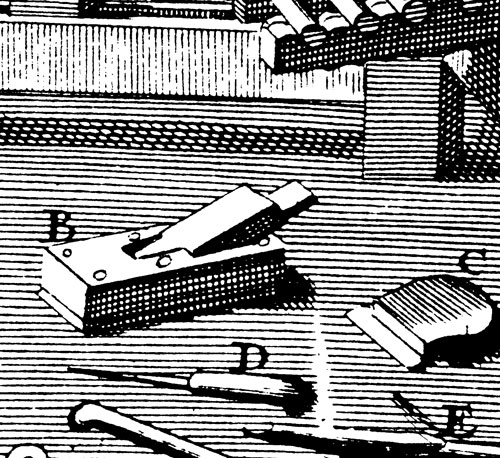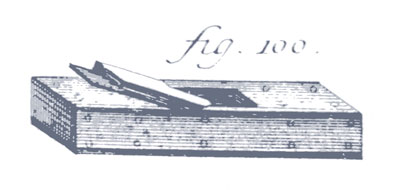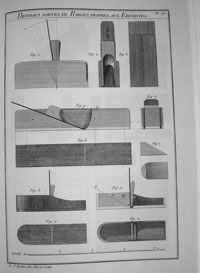 The English mitre plane has been with us since the latter quarter of the 18th century. Older surviving mitre planes do exist but I only know of one English model, all the others are from the Continent. It is generally thought that before C. 1780 or so the extant metal planes were essentially one off designs or very expensive limited production. This all makes a lot of sense in the larger context of the industrial revolution and the English economy. We have hard evidence in the account books of Christopher Gabriel that in 1791 Gabriel was manufacturing mitre planes as part of his regular inventory. When the Gabriel mitre planes do arrive, the planes along with mitre planes by other makers, appear fully formed. You don't see the gestation period that you do with panel planes or smooth planes, both which took a 20 year period or so to mature in the 1830's and onward. However, and this is what I find puzzling - why was it called a mitre plane in the first place? The English mitre plane has been with us since the latter quarter of the 18th century. Older surviving mitre planes do exist but I only know of one English model, all the others are from the Continent. It is generally thought that before C. 1780 or so the extant metal planes were essentially one off designs or very expensive limited production. This all makes a lot of sense in the larger context of the industrial revolution and the English economy. We have hard evidence in the account books of Christopher Gabriel that in 1791 Gabriel was manufacturing mitre planes as part of his regular inventory. When the Gabriel mitre planes do arrive, the planes along with mitre planes by other makers, appear fully formed. You don't see the gestation period that you do with panel planes or smooth planes, both which took a 20 year period or so to mature in the 1830's and onward. However, and this is what I find puzzling - why was it called a mitre plane in the first place?
The purpose of these blog entries is to put forth a theory that tries to put all these questions in perspective and pose answers. What is missing is the smoking gun. I am hopeful that on reading this someone can provide that.
Several things bother me:
Shooting mitres and crosscuts in general are one of the most common operations in woodworking - yet mitre planes are pretty rare and the late 18th century and early to mid 19th century literature makes almost no reference to them. In Moxon's Mechanick Exercises (1683) Moxon carefully and completely describes the use of a strike block plane to shoot mitres. A strike block plane is a high angle wooden plane. Moxon's instructions for using a strike block plane to shoot mitres bothers me a lot. First of all it is the first reference of the word "mitre" in the context of woodworking, secondly if the mitre plane was an important tool for shooting mitres he would have mentioned it. The reason he would have mentioned it is that he knew all there was to know about metal planes. The illustrations for Mechanick Exercises were copied directly from a slightly earlier book Andre Felibien's Des Principles de l'Architecture and if metal planes were used in joinery Moxon would have mentioned it. We can make this assumption because Felibien mentions and illustrated a "mitre plane" - only he doesn't call it that. This is the first contemporary illustration (shown above) of a mitre plane only it's in the section on marquetry and is described as "a plane covered in iron". While it does look that the metal base might be screwed or riveted to a wood core in essence here we have all the elements of the mitre plane intact and ready for work.
There is no mention of metal planes in Felibien's joinery section but both he and Moxon would have known that a high angle bench plane works wonderfully for end grain. For normal work a heavy metal mitre plane isn't nearly as handy or as effective as a regular bench plane. However to level the surface of the exotic woods and materials used in marquetry in preparation for gluing or for final finishing you cannot beat a metal plane. What other type of plane would consistently be able to plane hard brittle materials with crazy grain such as fancy burls and ivory that are used in marquetry? The soles of regular wooden planes would be torn up very quickly by these materials. The fine mouth of a mitre plane would also do wonders on exotic woods to prevent tearout.
 The next mention of a mitre plane is in the Diderot Encyclopedia (1751 - 1772). The encyclopedia is a compendium of all the knowledge the authors could find at the time and the metal mitre plane is illustrated and described here too. Again the description is in the marquetry section of the encyclopedia and omitted from the cabinetmaking and joinery sections. The description as a plane covered in iron is similar to Felibien. The next mention of a mitre plane is in the Diderot Encyclopedia (1751 - 1772). The encyclopedia is a compendium of all the knowledge the authors could find at the time and the metal mitre plane is illustrated and described here too. Again the description is in the marquetry section of the encyclopedia and omitted from the cabinetmaking and joinery sections. The description as a plane covered in iron is similar to Felibien.
 Shortly after the Diderot encylcopida was published Andre Roubo wrote L'Art du Menuisier ( The Art of the Carpenter) (1769 - 1774 ) which is 5 volume opus on all sorts of woodwork. Here for the first time we have an actual cabinetmaker writing and metal soled mitre planes are given a page of illustrations. But again this is in the marquetry section. (Please click on the illustration to see the entire page). Shortly after the Diderot encylcopida was published Andre Roubo wrote L'Art du Menuisier ( The Art of the Carpenter) (1769 - 1774 ) which is 5 volume opus on all sorts of woodwork. Here for the first time we have an actual cabinetmaker writing and metal soled mitre planes are given a page of illustrations. But again this is in the marquetry section. (Please click on the illustration to see the entire page).
I am not aware of any surviving mitre planes that match the descriptions in these books. Metal planes of the period that have survived include mitre planes but they typically are more decorative than are illustrated in the books.
Finally a mere 20 years after Roubo metal planes show up in the inventory of Christopher Gabriel, a London planemaker. Lots of things can happen in 20 years.
In part two we will look at the early English metal plane makers and see how the marquetry plane became a mitre plane.
(note - due to a computer error I erased the original published draft of this article and have had to reconstruct it. Hopefully I haven't left anything out.)
|
 Joel's Blog
Joel's Blog Built-It Blog
Built-It Blog Video Roundup
Video Roundup Classes & Events
Classes & Events Work Magazine
Work Magazine


 The English mitre plane has been with us since the latter quarter of the 18th century. Older surviving mitre planes do exist but I only know of one English model, all the others are from the Continent. It is generally thought that before C. 1780 or so the extant metal planes were essentially one off designs or very expensive limited production. This all makes a lot of sense in the larger context of the industrial revolution and the English economy. We have hard evidence in the account books of Christopher Gabriel that in 1791 Gabriel was manufacturing mitre planes as part of his regular inventory. When the Gabriel mitre planes do arrive, the planes along with mitre planes by other makers, appear fully formed. You don't see the gestation period that you do with panel planes or smooth planes, both which took a 20 year period or so to mature in the 1830's and onward. However, and this is what I find puzzling - why was it called a mitre plane in the first place?
The English mitre plane has been with us since the latter quarter of the 18th century. Older surviving mitre planes do exist but I only know of one English model, all the others are from the Continent. It is generally thought that before C. 1780 or so the extant metal planes were essentially one off designs or very expensive limited production. This all makes a lot of sense in the larger context of the industrial revolution and the English economy. We have hard evidence in the account books of Christopher Gabriel that in 1791 Gabriel was manufacturing mitre planes as part of his regular inventory. When the Gabriel mitre planes do arrive, the planes along with mitre planes by other makers, appear fully formed. You don't see the gestation period that you do with panel planes or smooth planes, both which took a 20 year period or so to mature in the 1830's and onward. However, and this is what I find puzzling - why was it called a mitre plane in the first place? The next mention of a mitre plane is in the Diderot Encyclopedia (1751 - 1772). The encyclopedia is a compendium of all the knowledge the authors could find at the time and the metal mitre plane is illustrated and described here too. Again the description is in the marquetry section of the encyclopedia and omitted from the cabinetmaking and joinery sections. The description as a plane covered in iron is similar to Felibien.
The next mention of a mitre plane is in the Diderot Encyclopedia (1751 - 1772). The encyclopedia is a compendium of all the knowledge the authors could find at the time and the metal mitre plane is illustrated and described here too. Again the description is in the marquetry section of the encyclopedia and omitted from the cabinetmaking and joinery sections. The description as a plane covered in iron is similar to Felibien.  Shortly after the Diderot encylcopida was published Andre Roubo wrote L'Art du Menuisier ( The Art of the Carpenter) (1769 - 1774 ) which is 5 volume opus on all sorts of woodwork. Here for the first time we have an actual cabinetmaker writing and metal soled mitre planes are given a page of illustrations. But again this is in the marquetry section. (Please click on the illustration to see the entire page).
Shortly after the Diderot encylcopida was published Andre Roubo wrote L'Art du Menuisier ( The Art of the Carpenter) (1769 - 1774 ) which is 5 volume opus on all sorts of woodwork. Here for the first time we have an actual cabinetmaker writing and metal soled mitre planes are given a page of illustrations. But again this is in the marquetry section. (Please click on the illustration to see the entire page).
Also, there was an extensive migration of French Calvinists to England and
other European countries in an attempt to avoid Catholic persecution. Many
were weavers and cabinet makers. Given the secrets in the trades in pre-
industrialised England (?and the rest of Europe) perhaps French integration
was low and so the utility of their tools was not quickly known?
Looking forward to part two.
So, I suspect that the term derives itself from the angular form of the hat, and/or the sailmaker. Here is a link to a decent review of Mitre:
http://dictionary.reference.com/browse/mitre
On the word itself, "mitre" probably means "corner" in early English. I think the term Bishop's mitre and mitre as a mitre joint turn up concurrently - but part of that is both are very early words and there isn't much early English reference material.
"The Mitre" is a common name of pubs on a corner in England. Old pubs. what I don't recall from the OED is if the corner means comes from a bishops hat or the other way around. In any case it's about 200 years before the term "mitre plane" appears in print.
Neve makes no mention of a mitre plane or a metal mitre plane. The term "mitre plane" isn't even recorded until the 19th century. I would agree that at some point in the late 18th or more probably early 19th century the metal mitre came into the general joinery world for shooting but it came as a fully formed design used for marquetry not an evolution from a strike block. This is the whole point of my post and more on why this happened in part 2. I had thought I has made my case pretty clear. That the metal mitre solves some issues with a strike block plane design (and creates others) does not show any correlation in their development. I am also not aware of any wooden bevel up mitre planes which pre-date the common introduction of metal mitre planes in England in the late 18th century. It seems that the wooden mitre was made as a cheaper alternative to the metal mitre and post dates it.